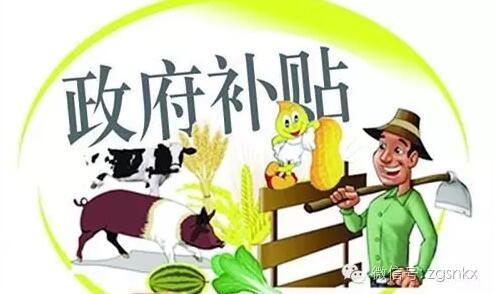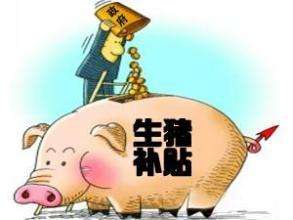2017 subsidy policy for agriculture, rural areas and farmers
On May 22, the Ministry of Finance and the Ministry of Agriculture issued the guidance on adjusting and improving the three subsidy policies for Agriculture (hereinafter referred to as the "guidance"). The adjustment and improvement of three agricultural subsidy policies, namely, subsidies for improved varieties of crops, direct subsidies for grain farmers, and comprehensive subsidies for agricultural materials, will be launched. Let's take a look at the relevant information today.

2017 subsidy policy for agriculture, rural areas and farmers
The people's governments of all provinces, autonomous regions, municipalities directly under the Central Government and municipalities separately listed on the State plan:
In recent years, the CPC Central Committee and the State Council attach great importance to the effective implementation of agricultural subsidy policy, and clearly require that while steadily increasing the intensity of agricultural subsidy, we should gradually improve agricultural subsidy policy, improve agricultural subsidy methods, and improve the effectiveness of agricultural subsidy policy. In accordance with the requirements of the third Plenary session of the 18th CPC Central Committee and the No. 1 document of the CPC Central Committee in recent years on improving the agricultural subsidy policy and reforming the agricultural subsidy system, and the unified decision-making and deployment of the CPC Central Committee and the State Council, the Ministry of Finance and the Ministry of Agriculture carried out in-depth investigation and research in view of the outstanding problems in the implementation of the agricultural subsidy policy, and put forward suggestions for adjusting and perfecting the agricultural subsidy policy on the basis of fully soliciting and extensively listening to the opinions of all parties. With the consent of the State Council, it has decided to adjust and improve three subsidy policies (hereinafter referred to as "three subsidies" for agriculture), including subsidies for improved varieties of crops, direct subsidies for grain farmers and comprehensive subsidies for agricultural materials from 2015. In order to actively and steadily promote the adjustment and improvement of the agricultural "three subsidies" policy, the following guiding suggestions are put forward:
First, 20% of the comprehensive agricultural subsidy funds should be adjusted nationwide to support the appropriate scale operation of grain.
(1) necessity. Since 2004, the state has successively implemented the agricultural "three subsidies", which has played a positive role in promoting grain production, increasing farmers' income and promoting the development of agriculture and rural areas. however, with the profound changes in the situation of agricultural and rural development, the effect of the agricultural "three subsidies" policy is decreasing, and the policy efficiency is gradually decreasing, which urgently needs to be adjusted and improved.
First, to change the mode of agricultural development, there is an urgent need to adjust and improve the agricultural "three subsidies" policy. The cost of agricultural production in our country is high, and the benefit of growing grain is low. The main reason is that the mode of agricultural development is extensive and the scale of operation is small. Restricted by small-scale operation, whether it is the popularization and application of advanced scientific and technological achievements, the provision of financial services, the effective docking with the market, or the promotion of agricultural standardized production, the improvement of the quality of agricultural products, the increase of production efficiency, and the promotion of market competitiveness, have encountered great difficulties. Therefore, to speed up the transformation of the mode of agricultural development, strengthen the ability of food security, and build a national food security and agricultural ecological security system, there is an urgent need to adjust and improve the agricultural "three subsidies" policy. we will increase support for appropriate scale operation of grain and promote the sustainable development of agriculture.
Second, to improve the effectiveness of the policy, there is an urgent need to adjust and improve the agricultural "three subsidies" policy. In most places, the "three subsidies" for agriculture have evolved into income subsidies for farmers, and some farmers can get subsidies even if they do not grow grain or land. However, new types of operators, such as large grain growers, family farms and farmers' cooperatives, who are really engaged in grain production, are difficult to get subsidies in addition to their own contracted farmland. The role of the agricultural "three subsidies" policy in arousing the enthusiasm of growing grain and promoting grain production has been greatly reduced. Therefore, it is urgent to adjust and improve the agricultural "three subsidies" policy to enhance the directivity, accuracy and effectiveness of the agricultural "three subsidies", to strengthen the support for the appropriate scale operation of grain, and to improve the effectiveness of the agricultural "three subsidies" policy.
(2) basic contents. According to the current decline in the prices of agricultural means of production such as chemical fertilizer and diesel oil, all provinces, autonomous regions, municipalities directly under the Central Government, and cities separately listed on the State plan should adjust 20% of the comprehensive agricultural subsidies issued in advance by the central finance. in addition, the pilot funds for subsidies to large grain growers and the incremental funds for the "three subsidies" in agriculture will be used as a whole to support the appropriate scale operation of grain. The support targets are moderate-scale producers and operators of major grain crops, focusing on new business entities such as large grain growers, family farms, farmers' cooperatives, and agricultural socialized service organizations, reflecting that "priority will be given to those who grow more grain."
Support the development of various forms of appropriate scale operation of grain, which can not only support the appropriate scale operation of land formed by orderly land circulation, but also support the cooperation of land shares and the mode of association or trusteeship of land, the way in which leading enterprises sign orders with farmers or cooperatives to achieve scale operation, and agricultural socialized service organizations to provide professional production services to achieve regional scale operation and other forms of grain scale operation.
All localities should adhere to the principle of adapting measures to local conditions, being simple and easy, and giving consideration to both efficiency and fairness, and adopt positive and effective support methods to promote appropriate scale operation of grain. We will focus on supporting the establishment and improvement of the agricultural credit guarantee system. Through the way of agricultural credit guarantee, we can provide credit guarantee and risk compensation for the loans of grain operators of moderate scale, and strive to solve the problems of "difficult financing" and "expensive financing" of new operators in the moderate scale operation of grain. The subsidy funds for supporting the moderate scale operation of grain are mainly used to support various localities, especially the major grain producing provinces, to establish an agricultural credit guarantee system, to promote the formation of a national agricultural credit guarantee system, to gradually build an agricultural credit guarantee network covering major grain producing areas and major agricultural counties, to strengthen the bank-load cooperation mechanism, and to support the appropriate scale operation of grain. Appropriate scale operation of grain can also be supported by means of discounted interest on loans, direct cash subsidies, major technology popularization and service subsidies. Appropriate subsidies shall be given to the loan interest of the appropriate scale operators of grain (no more than 50% of the loan interest). Direct cash subsidy should be linked to the planting area of major food crops or the area of technical extension services, and single-household subsidies should set a reasonable upper limit on the scale of subsidies to prevent "large households". Subsidies for major technology popularization and services may be provided by means of "service first and then subsidy" and providing material and chemical subsidies.
II. Select some areas to carry out the pilot reform of the "three subsidies" in agriculture.
(1) necessity. As a member of the World Trade Organization, China's subsidies to agriculture are restricted by the rules of the World Trade Organization. Continuing to increase the total amount of existing subsidies will further reduce China's support space within the overall scope of the rules of the World Trade Organization, which is not conducive to our country to make full use of the rules to mobilize the enthusiasm of grain farmers and further improve the income level of grain farmers. Therefore, it is necessary to reform the existing agricultural "three subsidies" system and convert some agricultural subsidies to the use of unrestricted subsidies in the rules of the World Trade Organization, such as the protection of cultivated land resources. At the same time, we will increase support for the moderate scale operation of grain. In order to actively and steadily promote the reform, it is necessary to select some areas to carry out pilot projects.
(2) the contents of the pilot project. In 2015, the Ministry of Finance and the Ministry of Agriculture selected five provinces, including Anhui, Shandong, Hunan, Sichuan and Zhejiang, to carry out pilot agricultural "three subsidies" reform. The main content of the pilot project is to merge the "three agricultural subsidies" into "agricultural support and protection subsidies", and the policy objective is adjusted to support the protection of cultivated land and the appropriate scale operation of grain. First, 80% of the stock of comprehensive subsidies for agricultural materials, plus direct subsidies for grain farmers and subsidies for improved varieties of crops, will be used for the protection of cultivated land. The object of the subsidy is all the farmers who have the right to contract cultivated land, and the farmers who enjoy the subsidy should not abandon the cultivated land and keep the soil fertility from being reduced. Subsidy funds should be linked to the area of cultivated land or sown area, and strictly control the boundaries of subsidy policies. The cultivated land that has been used as animal husbandry farms, woodland, grain fields converted into facility agricultural land, non-agricultural requisitioned (occupied) cultivated land and other arable land that have been changed, as well as cultivated land that has been discarded for years and whose area and quality in the occupation-compensation balance do not meet the conditions for cultivation will no longer be subsidized. At the same time, it is necessary to mobilize farmers to strengthen their awareness of the protection of agricultural ecological resources, take the initiative to protect soil fertility, and encourage straw to be returned to the field without burning in the open air. The subsidy funds used for the protection of cultivated land are directly subsidized to households in cash. Second, 20% of the stock of comprehensive subsidies for agricultural materials, plus pilot funds for subsidies for large grain growers and incremental funds for the "three subsidies" in agriculture, to support appropriate scale operation of grain in accordance with the requirements of unified adjustment and improvement policies throughout the country.
Related
- A course of planting techniques and methods on how to grow carrots
- How to plant the latest tulips?
- Is it better to pick tea in the morning or in the afternoon? When is the best time for tea to be picked? what is the third or fifth tea?
- Launch Yuanxiao Happy combination Haocha + Tea Yuan healthy Taste
- Penghu Tourism "Fireworks 20 Parade with You"
- 2022 West Lake Happiness holds "Digital Revitalization Voucher" and draws iphone13 and laptop.
- Banqiao Fuzhou social houses are designed to change start-up combined with police elimination to create a safe and livable environment
- The convenient measure of "mechanical weeding" in Xinbei has been abused and the Agriculture Bureau has imposed heavy penalties on the illegal land consolidation.
- Changgeng University Joins Hands with Four Memory Factories to Rescue Memory Talent Shortage
- The list of Taiwan's top 100 MVP managers is listed by the Director-General of the Farmers' Association of Sanxia District.



